Replacing heating radiators: a guide to removing old batteries and installing new devices
If your apartment is cold in winter, your heating radiators most likely need to be replaced.Traditional batteries made of cast iron or steel become dirty over time.
The coolant moves through old appliances in a thin stream and does not provide thermal energy sufficient for normal heating of the home. To improve the thermal conditions, it is worth dismantling old equipment and installing new ones, but for optimal results you need to know how to do the job correctly.
In this material we will talk about how to properly dismantle old radiators and install new devices in their place.
The content of the article:
What do you need to think about in advance?
If the decision to carry out this type of repair is made, you should find answers to a number of questions:
- When exactly and by whom will the work be carried out?
- Which type of radiators should I use it?
- Is it necessary to replace the pipes leading from the battery to the riser?
- How many sections will be needed for each room?
It is best to carry out such alterations in the summer, because before starting work you must obtain permission from the local housing office. In winter, officials are extremely reluctant to give such permissions, because they will have to shut off the common riser and leave other apartments without heating for some time.
But even outside the heating season, obtaining permission can be difficult. Those who have already solved similar problems talk about the need to wait several days, try to get an appointment with the right employees, etc. Some faced pressure: they were recommended to hire plumbers from the housing office to carry out all the work.
There are no restrictions in this matter.The main thing is that the replacement of heating batteries is carried out by an experienced plumber with appropriate qualifications. It is possible to identify all the flaws caused by inept installation only during operation.
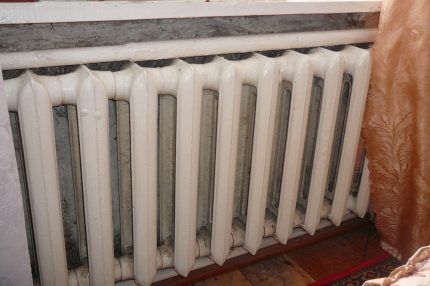
It is best to go to the housing office in the summer, and not in the fall, when queues peak. At this point, all the necessary materials need to be purchased, pre-assembled radiators, prepared tools, agreed with the team, if necessary.
If the house is connected to a central heating system, you should contact the maintenance service to coordinate the alteration. Here they can perform the necessary calculations to accurately determine the number of radiator sections, as well as clarify other technical issues.
You can calculate the required number of heating radiators yourself. We described in detail how to do this in this article.
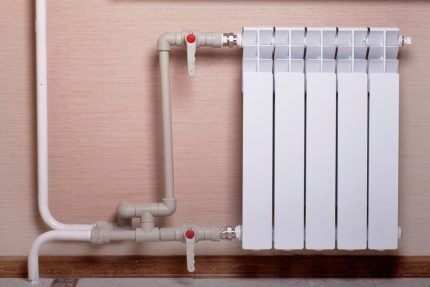
Lack of correct calculations can lead to imbalance of the home heating system.
For calculations, you will first need the information that is in the DEZ:
- type of boiler room (it can be central or individual for a particular house);
- type of system: two- or one-pipe;
- parameters of existing supply pipes;
- coolant characteristics: temperature, pressure, pH, etc.
Most often, old batteries are replaced with new modern models, usually aluminum or bimetallic. Although cast iron, copper and steel products are also available for sale. The type of radiator is needed when performing calculations.
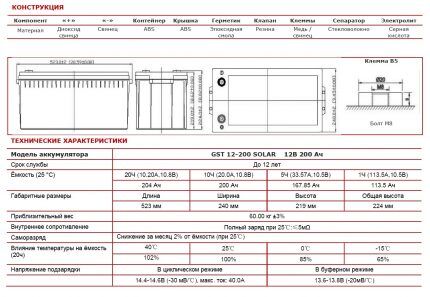
You will need such indicators as the pressure that the device can withstand, the maximum temperature of the coolant, heat transfer and other data. They can usually be found in the technical data sheet.
If not only the radiators are to be replaced, but also the pipes leading to them, you should choose a suitable material. This is usually steel, metal-plastic or polypropylene. Some craftsmen strongly recommend using only steel communications for centralized systems.
Depending on the type of pipes chosen, you will need appropriate equipment for welding them. MP and PP pipes are easier to install than steel. To work with metal, you need not only a welding machine, but also a device for cutting threads. Therefore, if the old pipes are clean enough, it is recommended to leave them and replace only the battery.
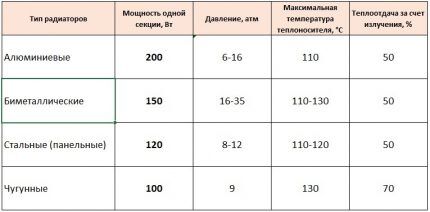
The weak point of metal-plastic structures is the connections. They must be performed very carefully; installation errors often lead to leaks. The popularity of MP pipes is explained by their relatively low price. Plastic is more expensive, but more reliable; if the welding is done correctly, the tightness of the joints will be very high.
You need to select suitable fasteners for the selected radiator.In this case, you need to take into account both the type of radiator and the material of the wall on which the installation will be carried out: brick, concrete, etc. Batteries are usually equipped with brackets of a suitable type.
To install one radiator, two brackets are usually used at the top and one at the bottom. Their position is carefully checked with a level to eliminate the possibility of misalignment during battery installation. However, some models are installed with a slight slope to ensure the removal of air trapped in the system. If the number of sections is more than twelve, another top bracket may be needed.
Radiator placement rules
Batteries are most often placed under the window to compensate for heat loss when cold air enters through the opening.
In this case, the following distances must be maintained:
- from the wall - 20 mm;
- from the floor - 120 mm;
- from the window sill - 100 mm or more.
It is advisable that the window sill does not overlap the radiator too much for effective air circulation in the room. These figures are guidelines only and may be higher or lower, although noticeable changes may affect the heat output of the structure.
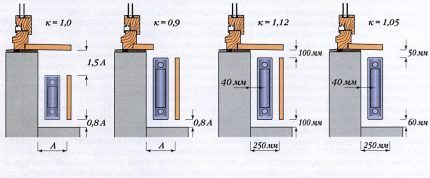
To improve the situation, it is recommended to cover the wall behind the radiator with a reflective material, such as penofol. Although some masters consider this measure useless. But he's beautiful decorative screen will become an obstacle to warm air, it is better to refuse it. Modern batteries look quite attractive; there is no point in hiding them.
Work order
To properly replace heating radiators in an apartment, you must:
- Coordinate the modification with the operation service.
- Purchase the necessary materials.
- Perform preliminary assembly of components.
- Prepare tools.
- Agree with the team (if you do not plan to do the work yourself).
- Register the alteration with the Housing Office and decide on the date for the work.
- Remove old radiators.
- Install brackets.
- Hang new batteries.
- Make connections to heating pipes.
- Check the system operation.
During the preliminary assembly of the units, all necessary elements are installed: plugs, gaskets, Mayevsky cranes and so on. In addition, you can mark in advance the places where the pipes will be cut. In this case, you should use a plumb line and level to ensure that the new radiator is level.
If the supply pipes also require replacement, it is necessary to prepare these elements: cut pieces of suitable length, attach tees, etc. All this is done in order to quickly complete the installation after draining the water from the heating system. This measure will be more than relevant if the need to replace old batteries arises during the heating season.
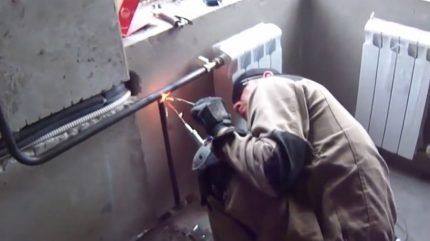
The procedure for removing old batteries depends on whether the pipes also need to be replaced. If the supply lines need to be preserved, you will have to carefully unscrew the old battery. At the same time, it is important to maintain the squeegee - a sufficiently long thread on the edge of the pipe. The radiator is secured with a nut and coupling, which will have to be unscrewed.
The procedure can be quite complicated.If the parts do not budge, you can try to loosen the connection using anti-corrosion compounds. In the most extreme case, the radiator is simply cut off with a grinder. There should be at least 10mm of thread left. Burrs should be removed from it.

If it was not possible to maintain the flow, you will have to extend the pipes and also cut new threads. The removed locknuts can be reused in the future. installation of a new radiator. It is much easier to dismantle the radiator if the pipes are also replaced. In this case, they are simply cut off in a suitable place. This is usually where the system turns toward its neighbors above and below.
Now you need to install the brackets and then hang the new radiator on them. At this stage, it is sometimes necessary to adjust the length of the supply pipe. All that remains is to restore the threaded connection. It is very important to perform the compaction correctly. For this, flax or plumbing thread is usually used.
Some craftsmen do not recommend using FUM tape on such connections. The seal is wound clockwise so that it forms a cone growing from the edge of the thread. Then screw on the connecting nut. If some of the seal remains outside, this is normal. But its layer should not be too thick.
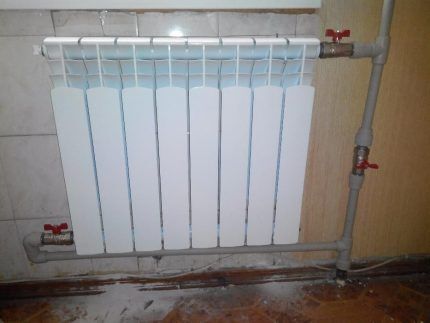
To achieve maximum tightness, sometimes the seal is impregnated with paint, after which the lock nut is screwed on. Then the protruding insulation is also impregnated with paint.A water-based composition is not suitable for these purposes. Once the paint has dried, it is very difficult to unscrew the connection.
Once the connection is complete, remove the protective film from the radiator. It is also necessary to check the position of the air vent. Its hole should be directed upwards. To check the quality of work, you need to ask plumbers to pump water into the heating circuit under pressure.
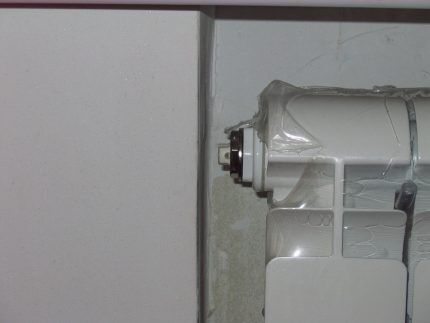
This will allow leaks to be identified and repaired immediately. During operation, it does not hurt to observe the radiator for the first time, and also check the condition of the connections to make sure that they are not leaking.
Some interesting tips
If you decide to replace old batteries, it won’t hurt to think about installing a faucet, either regular or with a thermal head. In the first case, you can manually regulate the coolant flow, in the second, this will be done automatically. But if you put it on the radiator thermostat, it does not need to be covered with a decorative screen.
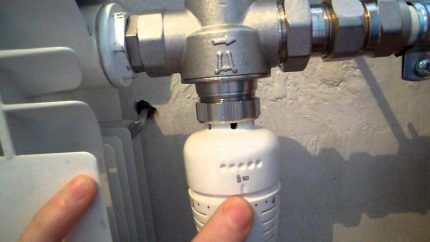
This will lead to data distortion when measuring temperature. It is worth noting that thermostats can only be installed in single-pipe systems. In any case, at least shut-off valves must be installed at the inlet and outlet of the radiator, if they are missing.
This will allow you to disconnect the radiator from the system to clean or replace it, regardless of the season. The thermal power reflected in the battery data sheet does not always correspond to the declared one.If you increase the number of sections by 10%, you can improve the situation.
Conclusions and useful video on the topic
How to choose a suitable replacement option:
Detailed master class:
Overview of common mistakes:
Inexperienced craftsmen should not start practicing on heating systems. There are many nuances in the process of replacing one radiator with another. Mistakes will result in costly repairs. It is better to entrust this task to experienced plumbers.
If you have experience in replacing heating radiators yourself, please share it with our readers. Perhaps you know the subtleties that we did not mention in this article? Tell us about them in the comments section.




Yes, the housing office makes money from this too. I went in June to have the water drained from the system. So they rolled out such a sum to me that I was dumbfounded. I came home, checked that there was no water in the system, and calmly prepared everything for replacement.
I bought polypropylene pipes, adapters for metal, and replaced 4 radiators in three days. The house is 9-storey, Soviet-built, with bimetallic radiators, bypasses and taps installed so that you can shut off and do something if necessary, even with a full system.
If you only need to change the radiator itself, then this is generally a ten-minute task. True, people usually now replace old cast-iron batteries with aluminum ones and, due to the difference in size, they also have to change the pipes. However, there is not much more work there. But you will immediately notice the difference in temperature. And modern batteries look much nicer than old cast iron ones. So, if you haven’t changed it yet, don’t be afraid and don’t delay.
I agree that changing the entire battery is not very difficult. Yes, in principle, even if a section is out of order, it can also be safely replaced (you will need a special key). All this is especially easy to do in a private house. But when it comes to purchasing an apartment, dancing with a tambourine and housing and communal services begins. And this epic is truly a blockbuster, so I myself don’t go near the radiators in the apartment - my nerves will be more intact.